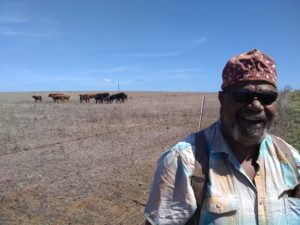
Daryl Kalua’u raises cattle on Hawaii’s Big Island where recent drought has left his pastures brown and thin.
By Patrick Lewis, FSA
Ranching is a tradition in Daryl Kalua’u’s family. His father and grandfather both worked as herdsmen for one of the largest ranches on Hawaii’s Big Island.
Originally not wanting to follow their footsteps, Daryl moved his family to Alaska where he operated heavy equipment on oilfields for 30 years. In 2000, he and his wife decided it was time to return home and start a ranch.
The Kalua’u operation is split into two herds. Half of his animals are located in South Point, the southern-most point of the United States. The other half of his herd is in the Kona area.
Today, his son Daryl Jr., the fourth generation of Kalua’u ranchers, tends to his father’s herd in South Point while building up a herd of his own.
Dry Island
On the big island, Daryl’s pastures are brown and thin, while five minutes up the road, the grass is as green as in a lawncare commercial.
Daryl’s ranch is located in the middle of what was considered a D3 (extreme drought) zone according to the U.S. Drought Monitor. The toll it took on his pastures left his cattle to range far to find enough feed.
“I wish we had somewhere else to put these cows,” he said. “But thank God for [USDA] and the help they’re able to give farmers like me.”
According to the University of Hawaii at Manoa, this region normally receives between 20 to 30 inches of rain annually. However, this island has been experiencing drought since the end of May, causing Daryl to supplement his herd with purchased feed. By doing this, he’s trying to maintain his cattle herd until much-needed moisture helps with pasture regrowth.
Buying Time
The Livestock Forage Program (LFP), administered by USDA’s Farm Service Agency (FSA), will buy Daryl time by helping to offset the feed he’s already had to buy.
While his herd in the Kona area is away from the worst of the drought conditions, most of the island has experienced drought recently, stressing herds island-wide.
“Because of the drought, the feed stores have been having trouble keeping up with feed needs,” Daryl said.
To help mitigate his risk, Daryl utilizes the FSA’s Noninsured Disaster Assistance Program (NAP). NAP provides financial assistance to producers of noninsurable crops when low yields, loss of inventory, or prevented planting occur due to natural disasters.
More Information
USDA offers a variety of risk management, disaster assistance, loan, and conservation programs to help agricultural producers in the United States weather ups and downs in the market and recover from natural disasters as well as invest in improvements to their operations. Learn about additional programs.
For more information about USDA programs and services, contact your local USDA service center.





